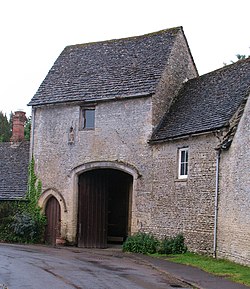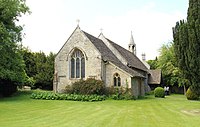Quenington
| Quenington | |
| Gloucestershire | |
|---|---|
 Knights Hospitallers' Gateway, Quenington | |
| Location | |
| Grid reference: | SP144044 |
| Location: | 51°44’10"N, 1°47’31"W |
| Data | |
| Population: | 603 (2011) |
| Post town: | Fairford |
| Postcode: | GL7 |
| Dialling code: | 01285 |
| Local Government | |
| Council: | Cotswold |
| Parliamentary constituency: |
The Cotswolds |
Quenington is a village in the Cotswolds in Gloucestershire, on the River Coln eight miles east of Cirencester and two miles north of Fairford.
The parish had a recorded population of 603 as at the 2011 census.
Important historic buildings include the late 11th century parish church, St Swithin's, and a large, mediæval dovecote above a gatehouse
The village has a village hall, a pub and a village green. Its economy has been transformed to render agriculture a minor but physically evident employer across most of the area: this area of the Cotswolds has been almost wholly been turned over from forest to agriculture, landscape parks and private or semi-private gardens. The working population divides almost equally into short-distance commuters and working-from-home groups, together accounting for approximately 88% of the working-age population in 2001. A significant minority work in the district's leisure, food and hospitality sector.
The Cotswold Water Park lies to the south and the Cotswold scarp is away to the north and west.

Parish church
The parish church, St Swithin's, was built around 1100, as records of this time show its dedication under the locally wealthy De Laci family. The Knights Templar took over the running of the church in 1193 from St Peter's Abbey, Gloucester, to whom the church had been granted (or by whom appropriated) 55 years earlier in 1138.
The church is Grade I listed.[1]
When first built, the church was dedicated to the Virgin Mary. It was then named ‘St Swithin’ following the 16th-century Reformation.[2] Its most notable features are two richly-decorated Norman doorways: the tympanum above the north doorway features the Harrowing of Hell, and that above the south doorway the Coronation of the Virgin,[1] said to be the oldest representation in Europe that is still in situ.[3] The church was extensively restored in the 1880s by Frederick Waller.[3]
History
The name 'Quenington' is first attested in the Domesday Book of 1086, where it appears as Qvenintone. This is from the Old English 'Cwenenatun' meaning 'women's town (or settlement').[4] It had previously been suggested that the name Quenington could have meant "settlement on the Coln", the river which flows through the village, though the name 'Coln' is of unknown origin.[5]
The Domesday Book states that Quenington had two mills, at either end of the village, a water mill and a fulling mill, both now private residences.[6]
John Marius Wilson's Imperial Gazetteer of England and Wales of 1870 describes Quenington as:
- "QUENINGTON, a village and a parish in Cirencester district, Gloucester. The village stands on the Fosseway and the river Coln, 2 miles N. of Fairford, and 8 E. by N. of Cirencester"[7]
Village hall
In 1906 the Quenington Institute was donated to the village by Thomas Bazley, a local landowner, to be used as a village meeting place. In January 2013, the village hall moved to new premises: the Gate on the Green had been used as a chapel since 1926 until services ended in 2010. The name was officially changed to Quenington Village Hall and the facility opened on 11 May 2013.[8]
In film, literature and the media
The village pub, The Keepers Arms, featured in the Four In A Bed reality series made by Channel 4 in the summer of 2014 and were crowned winners of the competition. The episode aired in early 2015.[9]
The pub also featured in Channel 5's Fifth Gear, where Dom Joly pointed a tank at it.
It stood in as the List and Newt pub in the fictional village of Crinkley Bottom in the 1990s TV series Noel's House Party.
Outside links
| ("Wikimedia Commons" has material about Quenington) |
References
- ↑ 1.0 1.1 National Heritage List 1341036: Church of St Swithin (Grade I listing)
- ↑ "Quenington, St. Swithin". http://www.britainexpress.com/attractions.htm?attraction=1565. Retrieved 26 March 2015.
- ↑ 3.0 3.1 "St Swithun, Quenington". The Church of England. https://www.achurchnearyou.com/quenington-st-swithun/. Retrieved 3 December 2016.
- ↑ Ekwall, Eilert, The Concise Oxford Dictionary of English Place-Names. Oxford, Oxford University Press, 4th edition, 1960. p. 377 ISBN 0198691033
- ↑ Rudge, Thomas (1803). The History of the County of Gloucester. Harris. https://books.google.co.uk/books?id=iQA-AAAAcAAJ&printsec=frontcover&source=gbs_ge_summary_r&cad=0#v=onepage&q&f=false. Retrieved 9 March 2015.
- ↑ Viner, David (1998). "Quenington Corn Mill and its Peripatetic Water Wheel". Gloucestershire Society for Industrial Archaeology Journal: 23. http://www.gsia.org.uk/reprints/1998/gi199823.pdf. Retrieved 25 March 2015.
- ↑ Wilson, John Marius (1870). Imperial Gazetteer of England and Wales. Edinburgh: A. Fullerton & Co.. http://www.visionofbritain.org.uk/place/11118. Retrieved 27 January 2015.
- ↑ "Quenington Village Hall, History". http://www.queningtonvillagehall.org.uk/page2.htm. Retrieved 29 March 2015.
- ↑ "Quenington pub crowned winner of popular TV show Four in a Bed". http://www.wiltsglosstandard.co.uk/news/cotswolds/11817796.Quenington_pub_crowned_winner_of_popular_TV_show_Four_in_a_Bed/?ref=rss. Retrieved 25 March 2015.
